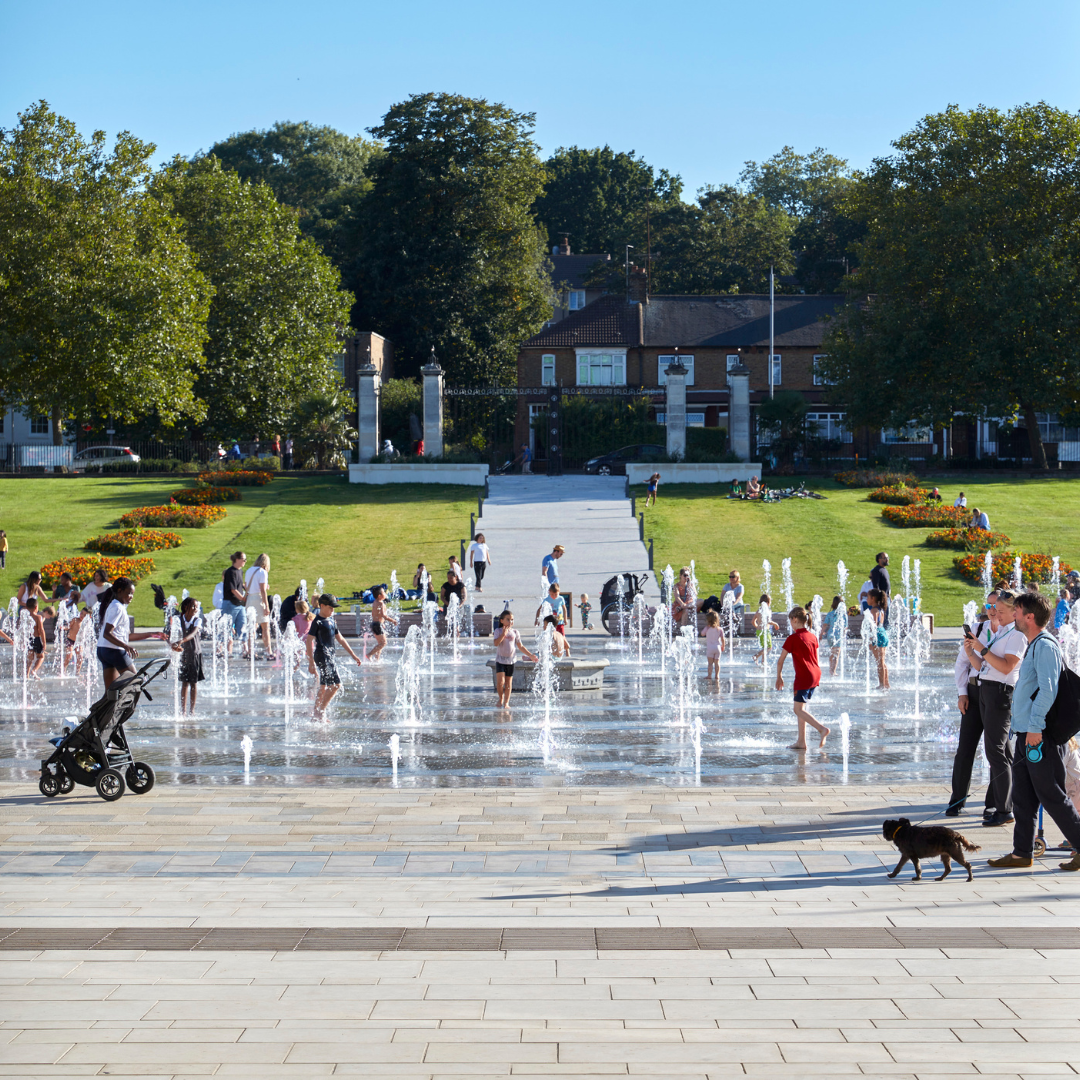Waltham Forest Town Hall, Waltham Forest, London – Waltham Forest Council with Hawkins\Brown and Churchman Thornhill Finch Landscape Architects

The refurbished Town Hall consolidates staff into one location and frees up vacated sites for much needed housing. Cellular offices are replaced with open-plan, agile workspaces to promote collaboration, wellbeing and productivity. A flexible foyer accommodates everything from collaborative working to evening events. An interactive water feature replaces creates a fully accessible forecourt while encouraging children to play.
Where is the project located?
Waltham Forest Town Hall, Forest Rd, London, E17 4JF
Who is the developer/client of the project?
Waltham Forest Council
Describe the social and environmental context of this project and its neighbourhood and people?
Waltham Forest Town Hall campus is situated on Forest Road in the London Borough of Waltham Forest, north east London. It was built by Philip Hepworth, who won a competition in 1932 to build a new civic campus, including a town hall, an assembly hall and the magistrates court around a formal landscape incorporating a central circular pool.
Due to wartime austerity measures The Magistrates Court was not constructed until 1971 in a Brutalist style and has been described as somewhat out of place against the Nordic Classicism style of the neighbouring buildings. The formal landscaping had remained but the feature fountain had become a vehicular roundabout.
Up until its redevelopment, most of the Town Hall was closed to the community. Public access was limited to the entrance area in front of the reception, and to the first-floor chamber for civic functions.
The majority of the Council’s workforce was also excluded, spread over several sites in the borough, resulting in inevitable operational inefficiencies.
The borough is also known for its rich cultural heritage, which is maintained today in the vibrant community of makers and creators in all fields of art, craft and design, and is reflected by its status as the London Borough of Culture 2019. The project has benefitted by the involvement of a number of members of this local creative and arts community ensuring the very DNA of Waltham Forest is embedded into the scheme.
Describe the intervention you’ve made including its purpose and motivation, as well as its viability or business case.
While numerous councils are converting their historic town halls into luxury homes, hotels, venues or workspaces, Waltham Forest recognised that the Town Hall Campus programme presented a once in a lifetime opportunity to create a vibrant new neighbourhood in the heart of the Borough, refurbish its cherished historic buildings and open it up to the public.
The new Waltham Forest Town Hall campus is a place for people – where residents, workers and visitors alike come together to enjoy a place that is active, inclusive and welcoming. It sets a new standard for integrating residential, workplace, civic, commercial and cultural functions in spaces that are permeable and inviting.
The project has transformed the way the Council operates and services the local community. The refurbished Town Hall consolidates staff into one location and frees up vacated sites for much needed housing. Cellular offices are replaced with open-plan, agile workspaces to promote collaboration, wellbeing and productivity.
The new civic campus is a democratic place where staff, residents and visitors should always feel welcomed and involved. A flexible foyer, accommodating everything from collaborative working to evening events, invites people in, while the civic suites accommodate both community celebrations and council business.
An interactive water feature replaces the tired fountain at the main entrance, encouraging children to play in the water on a hot day while also forming a fully accessible forecourt to host large scale events.
How does this project make use of an existing structure, place or building in a creative way? Is it innovative? How will this project continue to evolve or enable future flexibility and adaptation? Have you considered its resilience?
One of the key objectives of the project was to support the workplace transformation, enabling the council to adopt a new way of working and to continually evolve into the future.
The new Town Hall offers flexible, efficient and collaborative workspaces for council staff previously distributed all over the borough. It’s a democratic workplace that facilitates new ways of working through a range of work environments, from formal to informal, inside and out.
The existing cellular offices, once furnished with repetitive rows of desks, have been opened up and converted into clusters or neighbourhoods of open plan workspaces on each floor, facilitating a diverse range of working modes. The removal of internal partitions has enabled a far more efficient furniture layout.
By adopting an agile working desk system and using different types of furniture (kit-of-parts), users can choose an environment that is suitable for their work. As teams grow or shrink in size or working patterns change, furniture can easily be reconfigured to suit.
Should the council staff numbers decrease, some of the clusters can be turned in to co-working spaces for the community without the need for any major physical changes, and vice versa.
A highlight of the project was collaborating with local makers and craftspeople to design bespoke items for the building reflecting the borough’s rich cultural context, to create a revitalised, distinctive Town Hall for the people of the borough.
What is the environmental and social impact of the project? Please share evidence or data to support your entry
The project has truly transformed the way the Council operates and delivers services to residents. The Town Hall is now a welcoming civic building for the wider community, offering a vastly improved visitor experience of the Council’s services.
The health and wellbeing of Council employees has been one of the most important criteria for the design. By opening up the cellular offices and improving user flexibility, access to natural light and views, ventilation, the Town Hall is a far more comfortable place to work. Other improvements include better furniture, better welfare facilities (tea points, WCs, showers and cycle parking), biophilic design, better legibility and access to defined external working and social areas.
Upgrading and repurposing the existing Town Hall for extended use is a wholly more carbon efficient alternative to demolition. The design proposals were reviewed holistically ensuring a sustainable building that enhances the well-being of users and helps protect natural resources. We have reduced energy demand significantly, cut carbon emissions by over 20% and enhanced biodiversity and have achieved a BREEAM ‘Very Good’ rating.
The new water feature in Fellowship Square creates a reflection pool where kids can enjoy splashing about through the summer months. And a recirculating water system reduces water consumption.
Public art that is meaningful and relevant to the borough has been integrated, both inside and out, to celebrate the rich cultural history, the creative community and the legacy of becoming the first ever London Borough of Culture.
-
Early bird entry deadline: 15 December 2023
-
Final entry deadline: 25 January 2024
-
Festival of Pineapples: 15-19 April 2024
-
Awards party, London: May 2024
© The Pineapples - Tweak Ltd. 124 City Road, London, EC1V 2NX. Tel: 020 3326 7238
